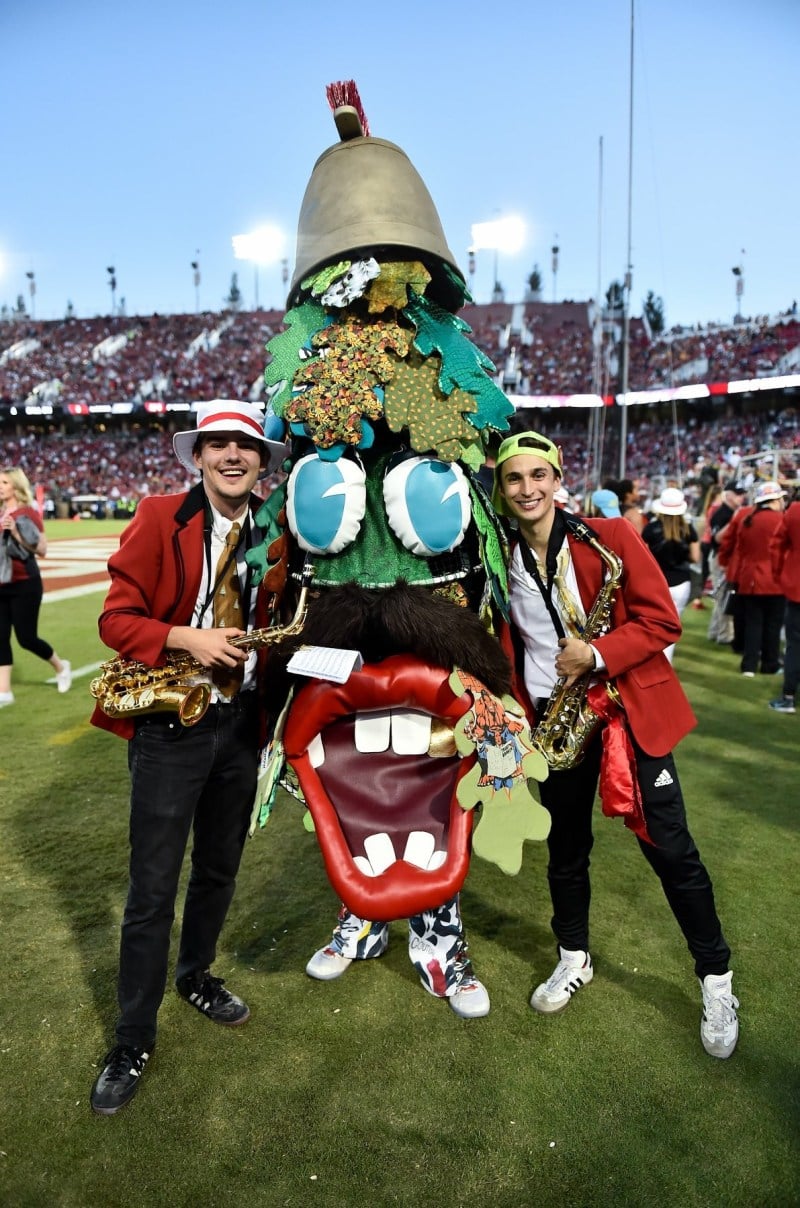Q&A with Dahkota Brown
Dahkota Brown ’20, the current Stanford Tree and mascot of the Leland Stanford Junior University Marching Band, made headlines last spring for a Tree Week campaign in which he dressed up as Donald J. Stump and asked Stanford students to “Make the Mascot Indian Again.”
Now the first Native Tree, Brown hopes to use his platform to showcase his heritage and reclaim Stanford’s fraught history with the Indian mascot. He sat down with The Daily to discuss performing his first games as Tree, designing his own costume and advocating for Native issues.
The Stanford Daily (TSD): What has it been like to dance in your first few football games?
Dahkota Brown (DB): It’s been pretty incredible. I think it was definitely a little bit tougher than I was expecting, but the experience has just been great. As the Tree, on game day for football, it’s a whole process. We have The Walk, and then we get into the stadium and go into our field shows and everything. It’s this huge ordeal for Band, but as the Tree, being able to lead us in all of that, and be at the front of the cadences, and be the face of the Band and be down on the field has been an incredible experience. I’m excited now that we have students back on campus. We’ll have a lot more attendance at the football games now and have the Redzone live. I’m hoping to interact with students some more.
TSD: You mentioned being the face of the Band. What does it mean to you to be the face of the Band and also so publicly represent your Native heritage?
DB: We have a couple outward-facing members of Band: the Tree, the drum major — those are the two most noticeable. I think being down on the field and being given that platform of representing Band and being Band’s mascot, paired with the intentional representation of my Native heritage and identity, has been something really special for me. I think being able to include Native artworks and visual representations of my heritage to the Tree costume has been really great.
TSD: How did you design your Tree costume?
DB: I took inspiration from past Trees in terms of the shape of it. As far as the leaves go, they’re pretty unique leaves in terms of [past] Trees. I ended up making oak leaves. One of the cool things about my leaves is that no two leaves are the same. I freehand drew all of the leaves, so they’re all different shapes. For me, this was an intentional thing, not because it’s an oak tree, but — being a California Native person — oak trees are pretty significant to my tribe. We make a lot of traditional dishes using acorns. There’s a lot of oak trees back where I’m from. That was something I wanted to represent in my design of the Tree.
I ended up a getting a couple fabrics from different Native artists, which was awesome. Having people respond and sending me stuff. I have a couple pretty noticeable ones on the Tree. One of them is from Native artist Steven Paul Judd, who does contemporary artwork. It’s his take on “The Incredible Hulk” as “The Indigenous Hulk.” I have a Bluebird Flour bag. A lot of Native communities use Bluebird Flour in their fry bread recipes, so I included that one. It was my great-grandmother’s flour bag that my grandparents still had, so I got to incorporate that into the Tree, and some different generic Native patterns. I think for me, being able to put those Native designs on the Tree and put a Native voice on a higher platform — especially as a visual representation where people see these designs and artwork from different Native people — that’s been really special.
TSD: Are you hoping to pair the Tree with more traditional activism here on campus?
DB: Definitely. I have a passion for activism, especially when it comes to Native issues. I think the Tree is kind of special in a way that it’s not the official university mascot. [Trees] don’t necessarily have to abide by all the university rules, so we can have our own voice and say that the Tree stands up for this cause, or that kind of thing. We can be political and push boundaries.
I would like to see the Tree get involved in some activist movements this year. It was announced that University has decided to rename Serra Mall and the Serra dorm, which is huge. That’s been a long process, and something that the Native students on campus have been fighting for going back a couple years. I have a lot of close friends who were on the renaming committee and a lot of people who have been advocating for this change, so that’s really awesome. To see that and be a part of that has been incredible.
TSD: Has there been any pushback from older alumni who still remember when the Stanford Indian was the school’s mascot?
DB: Not so far. I had one encounter where an older couple had asked to take a picture with the Tree. As we were taking the picture, the man said “Go Indians,” so I just kind of turned around and left and ended up not taking a picture with them. That’s the only thing that has happened so far. Other than that, as far as the people who do know that I am a Native person [who has] advocated for the change in Native mascots, I haven’t had anything but positive interactions.
This transcript has been lightly edited and condensed.
Contact Erin Woo at erinkwoo ‘at’ stanford.edu.
